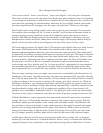More Thoughts from the Designer
Clean versus colored - Active versus Passive - Tape versus Digital - well it all gets a bit tiresome.
Here is the real deal: they are all a bit colored and for the most part remarkably clean. So if anything
we are basing our preferences on which flavor of subtle color we either happen to like, or believe we
need (based on something we read somewhere) which may be just a slightly familiar sound rather
than some magnificient life changing event. No magic, just good tools. The music is the magic.
Does Digital require some analog warmth, some color to make a great recording? Not necessarily.
For example some recordings call for "as clean as possible" and even some instruments within an
otherwise grungy mix may sound best or provide a wonderful contrast when made as clean as
possible. And while this designer doesn't claim that today's hi end digital is absolutely clean and
transparerent or clinical and sterile, adding more and more stages of processing whether analog or
digital will mostly tend to make it less transparent, less true to the source. Choose wisely.
Will some analog processor fix digital's flaws? This designer hears digital's flaws as a subtle form of
time smear. Much analog on the other hand can be characterized as having various forms of
harmonic and intermodulation distortion, plus often some time smear caused by phase shifts which
are practically inevitable given the normal frequency responses of audio gear. One form of distortion
doesn't cancel out the other and adding more time smear should make things worse. However, there
are some families of distortion that may be euphonic and either add to the effect of 3D depth, some
distortions give an effect of fatness or warmth (transformers), and some distortions that seem to
evoke vintage tone like a familiar smell. So 'as clean as possible' is appropriate for some situations
and somewhat controlled dirt is appropriate for others. Beware of getting the mind-set that either
goal is appropriate for every sound and every situation. Like every house should be the same color.
There are many situations where one might want a processor (or preamplifier) that doesn't leave its
thumbprint on the sound. Typically mastering is one place for a transparent EQ, especially when the
mix is already pretty damn fine. Other situations, of course include, most classical and live ensemble
or choir recordings, a lot of acoustic recordings, folk, country, jazz, choir, classical, etc. While the
MiniMassive does have very transparent gain stages, and the EQ sections are passive so they have
less artifacts at low to modereate settings than most op-amp based EQs, it should be pointed out that
significant drastic settings with any EQ (or compressor) regardless of how clean it started, will
probably leave a thumbprint. Sometimes 'natural' is very good goal, and it can be the most familiar.
The place to start is player, instrument, room then mic choice & position, preamp & converter. EQ?
With the MiniMassive, expect a generally clean and natural sound with conservative to moderate
settings. However, it will gradually introduce a signature color at more drastic settings. With the
transformer option, one can introduce some vintage color and subtle warmth. The downside with
iron, and there is always a downside, is some subtle time smear that might be noticed with sounds
that have lots of energy (and tightness) at the edges of the spectrum. Worth a check on big solid
mixes or kick drum tracks or high hat tracks. Drastic EQ settings (from any EQ) can 'time-smear'
too. EQ changes generally introduce phase shift so listen for time smear with spectrum changes.
And for those who have need for more color and more of that elusive vintage vibe, we designed
another EQ to do that function. It is called the Massive Passive, and it is a vacuum tube based unit
originally designed to be an alternative to the typical mostly boring EQs available then. Ya know?


















